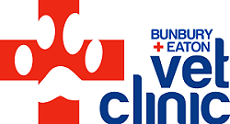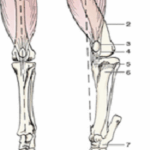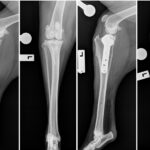
Feeding Your Dog.
What should I feed my dog? When it comes to feeding your dog, there are a lot of different thoughts and theories as to what is best. Is commercial food, a home cooked food, or a raw food diet the best?
I think the answer is all three can be good or bad, but they all need to be done well.
Keeping your dog and ideal weight.
Let’s start with the most important point – quantity. Far and away the biggest food related problem we see is simply overfeeding dogs. Excessive weight has similar issues in dogs to people, with increased risk of arthritis, cancer, heart disease and many other problems. A recent study conducted by a pet food company compared the life expectancy of Labradors which were overweight to those of an ideal weight. They found that the average life span of an overweight Labrador was 12 years, while those which were kept at an ideal weight lived for 15.4 years on average. That’s over three years difference!
My recommendation is you should be able to easily feel your dog’s ribs, but if you imagine them shaved you shouldn’t be able to see the ribs clearly. It is worth checking your dog’s body condition every few weeks, as changes in season and activity levels can lead to some fairly quick changes. It’s much easier to correct weight issues when they are quite minor rather than once the dog is very over or underweight.
The dogs we most often see weight issues in are the breeds that love their food, such as Labradors and Golden Retrievers, but also small breed dogs where the owners see them as fussy eaters.
Dogs such as Labradors and Golden Retrievers will eat far beyond the point of being full. I saw a dog once which had eaten seven kilograms of dog biscuits in one sitting. It had a huge belly and looked quite sorry for itself, but she was still wanting a treat from me.
The “fussy eaters” are also prone to being overweight. We actually find that they’re not really fussy, but simply not hungry. This may be because they are not food motivated, or more commonly just don’t need as much food as the owner thinks they do. We see this most often in small breed dogs.
We find the fussy eaters will not be hungry, so won’t eat the “normal” food they are offered. The owner gets a bit worried, so try something a bit more tasty. The dog eats some of that tasty food because it tastes so good, then gets full. It’s a lot like offering a kid a healthy meal. They will likely eat what they need, then go off and play. If you then offer them some chips or an icecream, they will probably come back and eat some more. If this is done on a regular basis, you end up with an overweight kid.
It’s amazing how often we see an overweight dog where the owner says “if I feed it any less it will starve to death”. A dog’s metabolism is much more efficient then ours, so they need much less food than we would necessarily think. It is a simple input/output equation, so if the dog is overweight it is receiving too many calories. If the diet is well balanced, it will still get all the nutrients it needs to stay healthy from a much smaller amount of food.
I find that many commercial dog foods recommend feeding more than most dogs need, though the actual amount required varies a lot depending on gender, size, sterilisation status and exercise levels. We recommend starting off feeding the recommended amount then adjusting as needed according to your dog’s body condition.
What to feed your dog.
This is always going to be a very polarising topic. Some people believe that commercial dog foods are the best way to feed dogs, while others firmly believe that a raw food diet is the only way to keep your dog healthy.
Personally, I think either diet can be good or bad, depending on the quality of ingredients and the balance of nutrients. We do need to remember that different dogs are going to have different nutritional requirements, so there is no “one size fits all” approach to feeding.
Commercial Dog Food:
I feed my own dog a commercial dog food. I use the Royal Canin foods, as they are well balanced, made from human grade food, and look after the specific needs of my dog.
It is probably obvious that a large dog such as a Great Dane needs different food to a Chihuahua, but many commercial diets aren’t designed to allow for these differences. Large breed dogs need controlled calories and nutrients to allow for ideal growth rates, while small breed dogs which are particularly prone to dental disease need biscuits designed to keep their teeth clean.
Feeding commercial food is great for people who don’t have the time to put together a well balanced food for their dog, or where the dog has a specific medical issue.
It is critically important to feed good quality dog food when using a commercial diet. Some foods cost as little as two dollars per kilogram, which makes me wonder what sort of quality ingredients are used. You will find that most vets can tell then a dog is on these cheap foods by the smell of their flatulence and the colour of their pooh (many of the artificial colours used will be passed straight through, giving a red tinge to the pooh). Just the same as you wouldn’t expect a child to thrive and be healthy on a poor diet, we can’t expect a dog to be at its best when fed rubbish.
Because many poor quality foods have a lot of fillers in them, you often need to feed quite a lot more to feed your dog sufficiently. This means you end up with more pooh passing through your dog, which you need to pick up, and the actual cost of feeding your dog is not that different to feeding a good quality diet where to feed a smaller amount.
For most dogs, we recommend biscuits over soft food such as tinned food or rolls. Soft food tends to be higher in fat, and also contributes to dental disease as it will leave more residue on the teeth.
Home Cooked Diets:
Home cooked diets can be good for your dog if well balanced. It is important to formulate the diet carefully to ensure the dog receives all the nutrients they need for their size and life-stage. I would recommend finding a good book with a variety of recipes.
Raw Food Diets:
These diets are based around the idea of what a dogs ancestors would have eaten. Think of it as paleo for dogs.
Proponents of this sort of diet argue that a wolf in the wild would have eaten their meat raw and ingested the contents of their prey’s stomach and intestines.
Raw food diets are normally based around fresh meat, raw bones or chicken frames and a mix of vegetables.
Opponents to raw food diets argue that a dog’s nutritional requirements have changed with domestication, and feeding raw meat increases the risk of certain pathogens in the faeces.
If feeding a raw food diet, it is very important to feed high quality meat and bones to reduce the risk of food poisoning and pathogens in faeces.
Feeding bones to dogs:
Feeding bones to dogs has benefits and risks. The Australian Vet Dental Association recommends not feeding bones to dogs due to the risk of tooth fractures, the wearing down of teeth, and the chances of bones causing blockages in the gut or constipation.
I do recommend feeding bones to dogs, as I think the benefits tend to outweigh the risks. It is important to only ever feed raw bones, and avoid feeding chop or knuckle bones as these can get stuck in a dog’s throat or intestines.
We know that chewing bones regularly helps keep teeth clean. Although we do see the occasional fractured tooth from chewing bones, I would estimate we pull out over 100 rotten teeth to every tooth fractured by eating bones. If you’re able and willing to brush your dog’s teeth daily then you’re probably better off not feeding bones as the risk of tooth fracture becomes greater than the risk of other dental diseases.
For puppies, I recommend feeding raw chicken wings. This teaches them to chew bones properly from a young age, and directs their chewing away from shoes, power cords and other things they may destroy as an alternative. Puppies need to chew things to help their teeth come through and develop a strong, healthy mouth, so providing a “good” object to chew is essential.
Whatever you choose to feed your dog, it is important to ensure it is high quality and the right quantity to maintain an ideal weight, clean teeth and a healthy dog.


